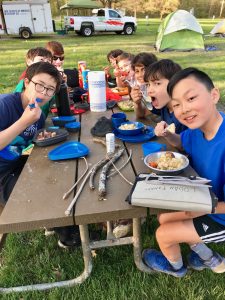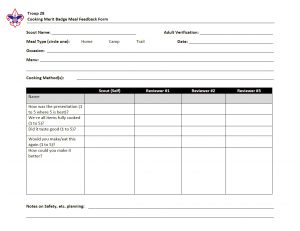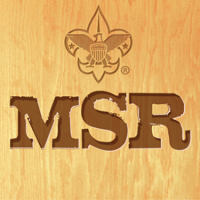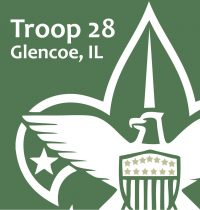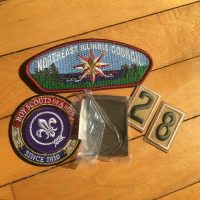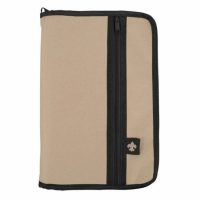Cooking Merit Badge is a great Eagle-required Merit Badge for scouts to start thinking about early in their scouting career. Home cooking should be done at home (!) and does not require troop involvement, so it can be done at the scout's own pace.
Many counselors accept trail cooking completed on non-scouting outings, and some even accept portable outdoor cooking on non-hiking activities (e.g., canoeing or hunting). And some counselors allow non-troop camping outings to count towards Cooking Merit Badge. As always, check with your counselor IN ADVANCE if you have any questions or are counting a particular outing to complete your badge.
Check out our resources including meal planning tips and recipe suggestions, cooking methods and tips, the MyPlate calorie calculator and daily meal plans, and recommendations for dealing with food allergies and intolerances.
Scouts and adult leaders who have a passion for cooking or an interest in learning more are encouraged to join the Cooking with Scouts BSA Facebook group for many more great tips and insights.
Need Inspiration? Check out what these scout-made culinary creations from Twitter!
Meal Evaluations
You are welcome to use the meal evaluation worksheets in the Merit Badge Workbooks. Here is another variation to help you capture key information about each meal you prepare.
Meal Planning Tips and Recipes
- Backpack Cooking Recipes from Troop 148
- Backpacking Recipes from Troop 204
- BSA Cooking's blog dedicated to the Cooking Merit Badge (check out their Trail or Backpacking meal ideas)
- Resources for Cookmasters (including instructions for Backpacking Cookmasters, a Backpacking Carry List, and suggestions for simple backpacking meals). from Troop 777
- Backpacking Food Ideas from Troop 26
- Basic ingredients for make-at-home dehydrated backpacking meals (Scouting Magazine, November 2013)
- Grubmaster Planner from Troop 889
- LoveTheOutdoors.com's camp cooking tips
- Menu Ideas Form Cooking Merit Badge Classes (unknown source)
- Mountain House's guide to how to prepare freeze dried food
- Outing Menu Planner – cooking methods, menus, cleaning tips, budgeting and shopping guides from Troop 219
- Pre-trip Food Prep tips for boating and other portable-cooking outings
- Scouter Mom's Cooking Merit Badge resources
- Scouter Mom's helpful links and recipes
- Scouting Magazine's Backpacking Meals Archive
- ScoutSmarts' Ultimate Guide to the Cooking Merit Badge including a detailed requirement-by-requirement
- TrailCooking.com's food, recipes, gear, tips & trips
Cooking Methods, Techniques, Tips, and Tricks
- Wristband Resources' campground cooking 101 with tips on building campfires, gear, and more (shout-out to Eli in Troop 78)
- What's So Great About 350 Degrees? This article from Atlantic magazine's science team explores the whys behind the most common moderate temperature for baking everything from cakes to pot roasts.
 |
Attention Dutch Oven chefs! You don't have to go out of your way to look for “dutch oven campout recipes” (although many of those are time-tested by scouts and campers. You can take many baked recipes and convert them to dutch oven recipes by using this handy dandy chart to convert conventional oven times and temperatures to dutch oven briquets quantity and , placement, and timing. Precise briquet count and timing is most critical for baked items or recipes with less liquid.
Many experienced scouters recommend the simpler ring method, especially for stews, soups, and other dishes with a higher liquid content. In short, a circle of briquets is placed on the top and bottom aligned with the circumferences (the top will be bigger). A similar rule of thumb is that the number of briquets on top will be 3 larger than the nominal circumference of the dutch oven (in inches), and 3 less than the bottom. So, for example, an 8″ dutch oven would start with 11 (8+3) briquets on top, and 5 (8-3) on the bottom. An extra briquet or one shy is probably close enough. Stirring and replenishing the coals will maintain a roughly 350-350 degrees F temperature, which is the sweet spot for most common baking. More details are available on the YouTube video suggested by the scouters in the Cooking with Scouts BSA Facebook group. |
Healthy Eating and the USDA's MyPlate Program
To learn about healthy food choices, you can use the USDA's MyPlate calculator below to determine your daily caloric needs, and then find the appropriate MyPlate Plan planner for your recommended daily intake and age:
Please click on the link below for the recommended calorie intake for your age and activity level (as determine by the MyPlate calculator to the left).
Additional resources from ChooseMyPlate.gov: Sites on nutrition and conditions that can be exacerbated by dietary choices:
Cooking safety resources:
|
Allergies and Food Intolerances
Here are some references for parents and scouts interested in learning more about food allergies:
- Food allergy vs. food intolerance: What's the difference? (from the Mayo Clinic)
- BSA's Guidelines for Managing Food Allergies (last revised 2013)
- The Helpful Scout's Guide to Camping with Scouts with Allergies
- Resources for families without food allergies
- Article about food allergies by a Glencoe-raised EMT: Cashew-Containing Kale Chip Teaches EMT That He’s Not Invincible
- Highland Park-based Girl Scout Gold Project resources on allergy awareness
- Gluten-free recipes from Beyond Celiac
- How to make your (Cub Scout) pack food-allergy friendly for all boys (2014 article from Scouting Magazine pre-dates the inclusion of girls in BSA programs)
- Cooking Health and Safety – Food Allergies, Intolerances and Sensitivities (Chefsville)

